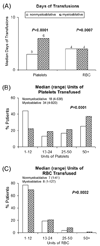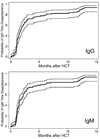The impact of donor type and ABO incompatibility on transfusion requirements after nonmyeloablative haematopoietic cell transplantation
- PMID: 20067562
- PMCID: PMC2864362
- DOI: 10.1111/j.1365-2141.2009.08073.x
The impact of donor type and ABO incompatibility on transfusion requirements after nonmyeloablative haematopoietic cell transplantation
Abstract
We retrospectively analyzed transfusion requirements within the first 100 d among allogeneic haematopoietic cell transplantation (HCT) recipients with haematological malignancies given either myeloablative (n = 1353) or nonmyeloablative conditioning (n = 503). We confirmed that myeloablative recipients required more platelet and red blood cell (RBC) transfusions than nonmyeloablative recipients (P < 0.0001 for both). Myeloablative patients given peripheral blood stem cells required less platelet transfusions (P < 0.0001) than those given marrow while RBC transfusion requirements did not differ significantly. Subsequent analyses were restricted to nonmyeloablative recipients. Platelet and RBC transfusions were less frequent among related compared to unrelated recipients (P < 0.0001 for both), with comparable median numbers of transfused units. Major/bidirectionally ABO-mismatched recipients required more RBC transfusions than ABO-matched recipients (P = 0.006). Rates of graft rejection/failure, grades II-IV acute and chronic graft-versus-host-disease (GVHD), 2-year relapse, 3-year survivals and non-relapse mortality were comparable among ABO-matched, minor-mismatched, and major/bidirectionally mismatched recipients (P = 0.93, 0.72, 0.57, 0.36, 0.17 and 0.79, respectively). Times to disappearance of anti-donor IgG and IgM isohemagglutinins among major/bidirectionally ABO-mismatched recipients were affected by magnitude of pre-HCT titres (P < 0.001 for both) but not GVHD (P = 0.71 and 0.78, respectively). In conclusion, nonmyeloablative recipients required fewer platelet and RBC transfusions and among them, both unrelated and major/bidirectionally ABO-mismatched recipients required more RBC transfusions. ABO incompatibility did not affect nonmyeloablative HCT outcomes.
Keywords: ABO-incompatibility; allogeneic HCT; nonmyeloablative conditioning; transfusion.
Conflict of interest statement
Figures






Similar articles
-
ABO incompatibility does not affect transfusion requirements or clinical outcomes of unrelated cord blood transplantation after myeloablative conditioning for haematological malignancies.Blood Transfus. 2022 Mar;20(2):156-167. doi: 10.2450/2021.0080-21. Epub 2021 Jul 2. Blood Transfus. 2022. PMID: 34369864 Free PMC article.
-
ABO mismatch may affect engraftment in multiple myeloma patients receiving nonmyeloablative conditioning.Transfusion. 2002 Feb;42(2):205-9. doi: 10.1046/j.1537-2995.2002.00027.x. Transfusion. 2002. PMID: 11896336
-
Severe immune hemolysis after minor ABO-mismatched allogeneic peripheral blood progenitor cell transplantation occurs more frequently after nonmyeloablative than myeloablative conditioning.Transfusion. 2002 Oct;42(10):1293-301. doi: 10.1046/j.1537-2995.2002.00209.x. Transfusion. 2002. PMID: 12423513
-
Alloreactivity as therapeutic principle in the treatment of hematologic malignancies. Studies of clinical and immunologic aspects of allogeneic hematopoietic cell transplantation with nonmyeloablative conditioning.Dan Med Bull. 2007 May;54(2):112-39. Dan Med Bull. 2007. PMID: 17521527 Review.
-
ABO-mismatched platelet transfusions: strategies to mitigate patient exposure to naturally occurring hemolytic antibodies.Transfus Apher Sci. 2010 Feb;42(1):83-8. doi: 10.1016/j.transci.2009.10.013. Epub 2010 Jan 19. Transfus Apher Sci. 2010. PMID: 20034854 Review.
Cited by
-
Impact of ABO-mismatch on risk of GVHD after umbilical cord blood transplantation.Bone Marrow Transplant. 2013 Aug;48(8):1046-9. doi: 10.1038/bmt.2013.8. Epub 2013 Feb 18. Bone Marrow Transplant. 2013. PMID: 23419434 Free PMC article.
-
Impact of ABO blood group mismatch in alemtuzumab-based reduced-intensity conditioned haematopoietic SCT.Bone Marrow Transplant. 2015 Jul;50(7):931-8. doi: 10.1038/bmt.2015.51. Epub 2015 Apr 13. Bone Marrow Transplant. 2015. PMID: 25867645
-
Favorable outcomes of intravenous busulfan, fludarabine, and 400 cGy total body irradiation-based reduced-intensity conditioning allogeneic stem cell transplantation for acute myelogenous leukemia with old age and/or co-morbidities.Int J Hematol. 2010 Sep;92(2):342-50. doi: 10.1007/s12185-010-0649-y. Epub 2010 Aug 10. Int J Hematol. 2010. PMID: 20694843 Clinical Trial.
-
Effect of major ABO blood group mismatched HSCT on blood transfusion and clinical outcomes in AA patients.Ann Hematol. 2025 Mar;104(3):1931-1947. doi: 10.1007/s00277-025-06213-4. Epub 2025 Mar 19. Ann Hematol. 2025. PMID: 40102306 Free PMC article.
-
Nonmyeloablative allogeneic hematopoietic cell transplantation.Haematologica. 2016 May;101(5):521-30. doi: 10.3324/haematol.2015.132860. Haematologica. 2016. PMID: 27132278 Free PMC article. Review.
References
-
- Anasetti C, Amos D, Beatty PG, Appelbaum FR, Bensinger W, Buckner CD, Clift R, Doney K, Martin PJ, Mickelson E, Nisperos B, O’Quigley J, Ramberg R, Sanders JE, Stewart P, Storb R, Sullivan KM, Witherspoon RP, Thomas ED, Hansen JA. Effect of HLA compatibility on engraftment of bone marrow transplants in patients with leukemia or lymphoma. New England Journal of Medicine. 1989;320:197–204. - PubMed
-
- Badros A, Tricot G, Toor A, Morris C, Guo C, Munshi N, Barlogie B, Cottler-Fox M. ABO mismatch may affect engraftment in multiple myeloma patients receiving nonmyeloablative conditioning. Transfusion. 2002;42:205–209. - PubMed
-
- Baron F, Vanstraelen G, Beguin Y. Transfusions after nonmyeloablative or reduced-intensity conditioning regimens. Leukemia. 2006;20:2081–2086. - PubMed
-
- Benjamin RJ, McGurk S, Ralston MS, Churchill WH, Antin JH. ABO incompatibility as an adverse risk factor for survival after allogeneic bone marrow transplantation. Transfusion. 1999;39:179–187. - PubMed
-
- Bolan CD, Childs RW, Procter JL, Barrett AJ, Leitman SF. Massive immune haemolysis after allogeneic peripheral blood stem cell transplantation with minor ABO incompatibility. British Journal of Haematology. 2001a;112:787–795. - PubMed
Publication types
MeSH terms
Substances
Grants and funding
LinkOut - more resources
Full Text Sources

